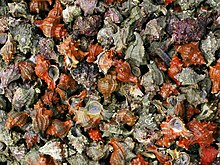The gastropods portalGastropods (/ˈɡæstrəpɒdz/), commonly known as slugs and snails, belong to a large taxonomic class of invertebrates within the phylum Mollusca called Gastropoda (/ɡæsˈtrɒpədə/). This class comprises snails and slugs from saltwater, freshwater, and from the land. There are many thousands of species of sea snails and slugs, as well as freshwater snails, freshwater limpets, land snails and slugs. The class Gastropoda is a diverse and highly successful class of mollusks within the phylum Mollusca. It contains a vast total of named species, second only to the insects in overall number. The fossil history of this class goes back to the Late Cambrian. As of 2017[update], 721 families of gastropods are known, of which 245 are extinct and appear only in the fossil record, while 476 are currently extant with or without a fossil record. Gastropoda (previously known as univalves and sometimes spelled "Gasteropoda") are a major part of the phylum Mollusca, and are the most highly diversified class in the phylum, with 65,000 to 80,000 living snail and slug species. The anatomy, behavior, feeding, and reproductive adaptations of gastropods vary significantly from one clade or group to another, so stating many generalities for all gastropods is difficult. The class Gastropoda has an extraordinary diversification of habitats. Representatives live in gardens, woodland, deserts, and on mountains; in small ditches, great rivers, and lakes; in estuaries, mudflats, the rocky intertidal, the sandy subtidal, the abyssal depths of the oceans, including the hydrothermal vents, and numerous other ecological niches, including parasitic ones. Although the name "snail" can be, and often is, applied to all the members of this class, commonly this word means only those species with an external shell big enough that the soft parts can withdraw completely into it. Slugs are gastropods that have no shell or a very small, internal shell; semislugs are gastropods that have a shell that they can partially retreat into but not entirely. The marine shelled species of gastropods include species such as abalone, conches, periwinkles, whelks, and numerous other sea snails that produce seashells that are coiled in the adult stage—though in some, the coiling may not be very visible, for example in cowries. In a number of families of species, such as all the various limpets, the shell is coiled only in the larval stage, and is a simple conical structure after that. (Full article...) Selected article Tyrian purple, also known as royal purple, imperial purple or imperial dye, is a natural purple-red dye which is extracted from certain sea snails, and which was first produced by the ancient Phoenicians. This dye was greatly prized in antiquity because it did not fade, instead it became brighter and more intense with weathering and sunlight. Tyrian purple was expensive: the 4th-century-BC historian Theopompus reported, "Purple for dyes fetched its weight in silver at Colophon" in Asia Minor. The dye substance is a milky mucous secretion from the hypobranchial gland of one of three species of medium-sized predatory sea snails that occur in the eastern Mediterranean Sea: Bolinus brandaris, the spiny dye-murex; the banded dye-murex Hexaplex trunculus; and the rock-snail Stramonita haemastoma. (Read more...) Selected biographyStephen Jay Gould (September 10, 1941 – May 20, 2002) was an American paleontologist, evolutionary biologist and historian of science. He was also one of the most influential and widely read writers of popular science of his generation. Gould spent most of his career teaching at Harvard University and working at the American Museum of Natural History in New York City. In the latter years of his life, Gould also taught biology and evolution at New York University near his home in SoHo. Gould's greatest contribution to science was the theory of punctuated equilibrium, which he developed with Niles Eldredge in 1972. Most of Gould's empirical research was based on the land snails Poecilozonites and Cerion, which are endemic to Bermuda and the Caribbean area respectively. Gould also contributed to evolutionary developmental biology, and has received wide praise for his book Ontogeny and Phylogeny. In evolutionary theory he opposed strict selectionism, sociobiology as applied to humans, and evolutionary psychology. He campaigned against creationism and proposed that science and religion should be considered two distinct fields, or "magisteria", whose authorities do not overlap. (Read more...) Did you know?
In the news2019 2018 2017
2016
2015
2014
2013
2012
2011
2010
Selected image The shell of the Venus comb murex Murex pecten has an extremely long siphonal canal. The shell has over one hundred spines, which provide protection from predation, and prevent the snail from sinking in the soft mud. This image shows three views of one shell: an apertural view on the right, abapertural view on the left, and apical view at the bottom. Lists of gastropods
Related WikiProjectsMajor topics
Related portalsSubcategoriesCategories about gastropods: Request to editors: please do not create any more categories of gastropods by country. Instead create list articles, article with a list of the marine or non-marine gastropods of whichever country or area you are interested in. We would also like to empty and delete the two remaining country categories we have, adding that information to list articles instead. Thank you. Things to do
Associated WikimediaThe following Wikimedia Foundation sister projects provide more on this subject:
|



































































